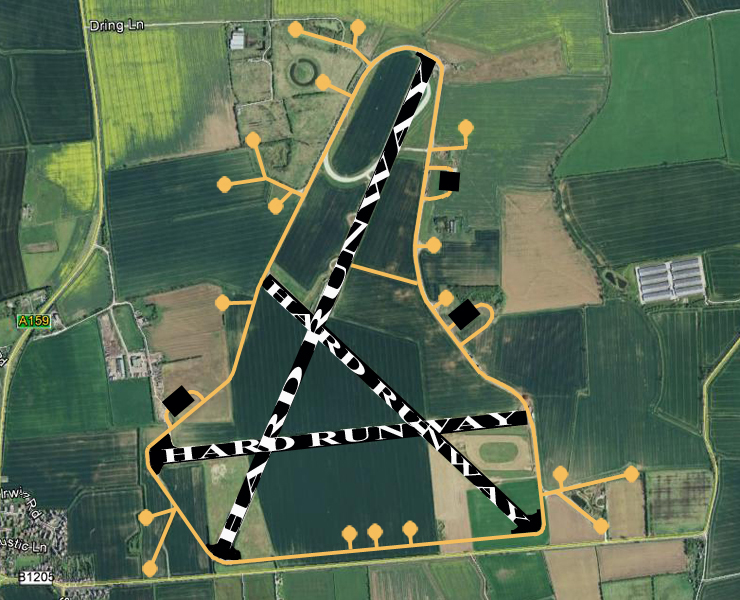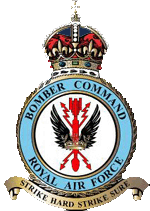Blyton Airfield History

(Map edited to show the airfield and runways between 1940-45)

© Crown Copyright/MOD 2010
53°27'5.8"N 0°41'39.2"WRunways:
09/27 & 14/32 4200ft x 150ft & 03/21 6000ft x 150ft
The first plans for an airfield were drawn up in early 1941, with construction swiftly starting soon after. The site chosen was only 1.5 miles from the village Blyton. As with most airfields built during this time period, Blyton was built to the standard Class ‘A’ pattern. This consisted of three runways crossing each other surrounded by a peri-track. Thirty six hard pan standings were built to cater for the impending heavy bombers due to arrive.
On the buildings side of the station, two T2 hangars along with one B1 hangar were erected. Both the accommodation and communal sites were constructed on the western side of the airfield, along the A159 which runs from north of Blyton village itself. When fully completed the station would be able to cater for a total of 1966 male and 389 female personnel. RAF Blyton was finally completed and opened on the 20th April 1942.
Once opened the station was immediately placed under the control of RAF Lindholme and 1 Group, Bomber Command, as a satellite station, but control was later moved again to Hemswell on 6th July 1942. With this latest change brought the first residents to the airfield in the shape of No.18 OTU ‘B’ Flight, Polish Air Force on the 10th July. In turn the first aircraft arrived at the airfield in the form of the Vickers Wellington, which No.18 OTU was currently using at their home base at Hemswell.
It was only a few months before the next arrivals would appear in the shape of No.1481 (B) ‘G’ Flight, on the 26th September. The new flight also brought with them not only the Wellington but a mixture of aircraft including the Armstrong Whitworth Whitley and the Boulton Paul Defiant. The flights arrival was nothing short of memorable, as one of the Defiants crashed on landing at the airfield.
No.1481’s stay was to be short lived though, and only a few months later, on the 3rd November, they were moved on to make room for the formation of No.199 Sqdn on the 7th November. The newly formed squadron received its first aircraft three days later, with the Vickers Wellington arriving. These aircraft were sourced from No.12 Squadron who were in the process of converting their fleet to the Avro Lancaster. The following month saw the squadron officially stand-up and began its operational life doing bomb and mine-laying duties. The squadron’s first operational mission was on the night of the 6th/7th December, when five Wellingtons were tasked with bombing Mannheim, Germany.
The following year saw even more change at station starting with the formation of 1662 HCU on the 1st February 1943. The new unit was to be made up of three aircraft types, the Avro Lancaster, Handley Page Halifax and the Avro Manchester. The unit was to have a total of thirty-two aircraft at full strength split over three flights, with ‘A’ Flight using the Lancasters and ‘B’ and ‘C’ Flights using the Halifax and Manchester, although initially only half the aircraft had arrived when they formed.
With the first arrival of the year, came the first departure with No.199 Squadron leaving only a few days later on the 3rd February 1943. Also the first control change of the airfield, when the station was returned to the control of Lindholme. In turn this subsequently led to the airfield being upgraded from a satellite to a sub-station. The next change was not directly at the station but affected its control. No.1 Group Heavy Conversion Base (later renamed 11 Base) formed on the 1st July 1943 at Lindholme, thus bringing Blyton directly under their control, but still as a sub-station.
In amongst all the station control changes, No.18 OTU had departed on the 27th March 1943 as Blyton established itself as a major bomber training station. More change was to follow with the formation of another training unit on the 21st November 1943. This time it was in the form of No.1 LFS (Lancaster Flying School) ‘B’ Flight, aimed at helping aircrews convert to the type at one place, rather than being spread around.
By now with all the heavy bombers using the airfield, the runway was starting to show signs of heavy wear and tear. So the decision was made to reduce the amount of aircraft at the airfield. This in turn led to No.1 LFS leaving the airfield on the 12th February 1944, leaving only 1662 HCU operating from the station.
The station remained quiet for several months until more control changes came their way. In October 1944, 7 Group was formed to take control of all Bomber Command training. With this came the renaming of 11 Base to 71 Base and the transfer from 1 Group to 7 Group, Bomber Command on the 5th November 1944.
Again everything fell silent at the airfield on the changes front until April 1945. With the war with Germany nearing an end the decision was made to disband 1662 HCU, and on the 6th April 1945 they were officially disbanded. By the 15th April all training had ceased at the station and the airfield fell quiet. During their time at Blyton, 1662 HCU lost over 50 aircraft in a variety of incidents, many of which resulted in them landing in surrounding farmland much to the displeasure of the local farmers.
June 1945 saw the arrival of 7 AHU (Aircrew Holding Unit) at the station. Their purpose was to accommodate aircrews after their initial training, while awaiting reallocation for further training at different airfields.
With the war now over the need for bomber crew training had reduced, so during June 1946, 7 AHU left the station after having had over 5000 aircrew pass through. This departure signalled the end for station and it was subsequently placed on Care and Maintenance on the 6th June 1946. The airfield then became a sub-site for 61 MU until they left in September 1951.
The departure of 61 MU sparked the re-activation of the airfield as a Relief Landing Ground, and during September 1951, No.101 FRS (Flying Refresher School) sent both Vickers Wellingtons and Gloster Meteors to be operated from the station. During February 1952, No.101 FRS was to be renamed No.215 AFS (Advanced Flying School), and operated solely Meteors from the airfield.
The sound of aircraft at the station was to be short lived though, and in May 1954, No.215 AFS left the station and it was immediately closed. No.61 MU then moved back to the airfield until it was finally sold-off during 1959.
Various sections of the station continued to be sold-off over the following years, until 1963 when the entire airfield had been sold. Over the coming years as the airfield fell in to disrepair, the buildings began to disappear and even the hangars were demolished.
Today much of the airfield buildings have gone, along with parts of both the runway and peri-tracks, with the majority being returned to farmland. There are still small signs of where once a building stood, whether it is a semi covered blast shelter or the footings on the old accommodation site.
But the northern part of the airfield still remains active to this day in the form of a motorsports race track owned by Blyton Park Driving Centre. Which you can race a variety of machines around part of the old northern peri-track and runway. In addition to this, a memorial plaque has been erected near the motorsports office commemorating all who served there.
| Date | Squadron | Notes |
|---|---|---|
| 20th April 1942 | Station opens. | |
| July 1942 | No.18 OTU Polish AF | Operating the Vickers Wellington. The Operational Training Unit left Blyton on 27th March 1943 1943. |
| September 1942 | 1481 (B) 'G' Flight | Operating the Vickers Wellington, Armstrong Whitworth Whitley, Boulton Paul Defiant and the Westland Lysander. The flight left the airfield on 3rd November 1943. |
| November 1942 | No.199 Sqn | Operating the Vickers Wellington. The squadron left Blyton on 3rd February 1943. |
| February 1943 | 1662 HCU | Operating the Handley Page Halifax and Avro Lancaster. The Heavy Conversion Unit disbanded at the station on the 6th April 1945. |
| November 1943 | No.1 LFS 'B' Flight | Operating the Avro Lancaster. The Lancaster Flying School left the airfield on the 12th February 1944. |
| June 1945 | No.1 AHU | The Aircrew Holding Unit left Blyton in January 1946. |
| March 1946 | 61 MU | The Maintenance Unit left Blyton in September 1951 |
| June 1946 | Station placed on Care and Maintenance. | |
| September 1951 | No.101 FRS | Operating the Vickers Wellington and Gloster Meteor. The Flying Refresher School was renamed No.215 AFS on the 11th February 1952. |
| February 1952 | No.215 AFS | Operating the Vickers Wellington and Gloster Meteor. The Advanced Flying School left the station in May 1954. |
| May 1954 | RAF Blyton closed and placed on Care and Maintenance. | |
| May 1954 | 61 MU | The Maintenance Unit left the airfield in 1959. |
| 1959-1963 | RAF Blyton sold-off. |
